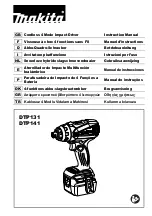
English
12
4.
Use a tightening time suitable for the screw
The appropriate torque for a screw differs according to the material and size
of the screw, and the material being screwed etc., so please use a tightening
time suitable for the screw. In particular, if a long tightening time is used in
the case of screws smaller than M8, there is a danger of the screw breaking,
so please confirm the tightening time and the tightening torque beforehand.
5.
Work at a tightening torque suitable for the bolt under impact
The optimum tightening torque for nuts or bolts differs with material and
size of the nuts or bolts. An excessively large tightening torque for a small
bolt may stretch or break the bolt. The tightening torque increases in
proportion to the operaton time. Use the correct operating time for the bolt.
6.
Holding the tool
Hold the impact wrench firmly with both hands. In this case hold the wrench
in line with the bolt.
It is not necessary to push the wrench very hard. Hold the wrench with a
force just sufficient to counteract the impact force.
7.
Confirm the tightening torque
The following factors contribute to a reduction of the tightening torque. So
confirm the actual tightening torque needed by screwing up some bolts
before the job with a hand torque wrench. Factors affecting the tightening
torque are as follows.
(1) Voltage
When the discharge margin is reached, voltage decreases and tightening
torque is lowered.
(2) Operating time
The tightening torque increases when the operating time increases. But the
tightening torque does not increase above a certain value even if the tool is
driven for a long time. (See
Fig. 19
)
(3) Diameter of bolt
The tightening torque differs with the diameter of the bolt as shown in
Fig. 19
.
Generally a larger diameter bolt requires larger tightening torque.
(4) Tightening conditions
The tightening torque differs according to the torque ratio; class, and length
of bolts even when bolts with the same size threads are used. The tightening
torque also differs according to the condition of the surface of workpiece
through which the bolts are to be tightened. When the bolt and nut turn
together, torque is greatly reduced.
(5) Using optional parts
The tightening torque is reduced a little when an extension bar, universal
joint or a long socket is used.
(6) Clearance of the socket
A worn or deformed hex. or a square-holed socket will not give an adequate
tightness to the fitting between the nut or anvil, consequently resulting in
loss of tightening torque.
Using an improper socket which does not match to the bolt will result in an
insufficient tightening torque. Matching socket and bolt sizes are shown in
Table 1
and
2
.
(7) Tightening torque varies, depending on the battery’s charge level.
Fig. 21
show examples of the relationship between tightening torque and
the number of tightenings, for WR14DSL. As shown, tightening torque
gradually weakens with the increase in the number of tightenings. In
particular, as the torque decreases very close to the complete discharge
(“a” margin in graph), the unit’s impact weakens, the number of time
impacts declines and tightening torque drops off abruptly. If this occurs,
check torque level, then recharge the battery if necessary.
kgf·cm N·m
150
100
50
0
1500
1000
500
0
0
1
2
3
kgf·cm N·m
150
100
50
0
1500
1000
500
0
0
1
2
3
200
2000
0
0
Fig. 19
Tightening time: sec.
(Steel plate thickness t = 25 mm)
Tightening torque
Tightening time: sec.
(Steel plate thickness t = 25 mm)
Tightening torque
Ordinary bolt (M12)
High tension bolt (M16)
Ordinary bolt (M16)
High tension bolt (M14)
Ordinary bolt (M14)
Save mode
Power mode
High tension bolt (M12)
01Eng_WH14DSL_EE
6/24/08, 13:40
12
Содержание WR 14DSL
Страница 96: ...95 1 2 3 4 5 11Back_WH14DSL_EE 6 24 08 13 49 95 ...
Страница 97: ...96 11Back_WH14DSL_EE 6 24 08 13 49 96 ...
Страница 98: ...97 11Back_WH14DSL_EE 6 24 08 13 49 97 ...














































